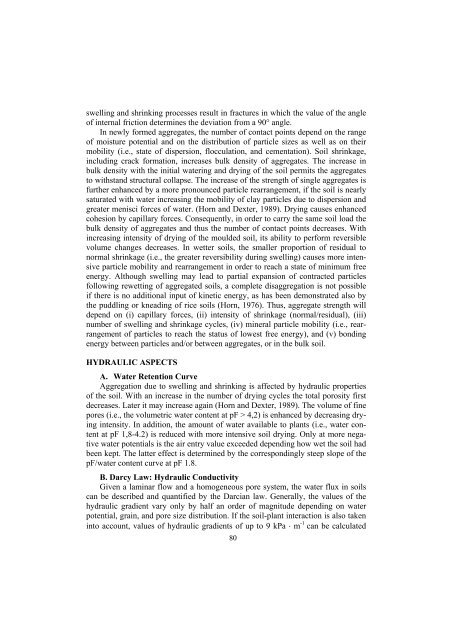soil - Lublin
soil - Lublin
soil - Lublin
You also want an ePaper? Increase the reach of your titles
YUMPU automatically turns print PDFs into web optimized ePapers that Google loves.
swelling and shrinking processes result in fractures in which the value of the angle<br />
of internal friction determines the deviation from a 90° angle.<br />
In newly formed aggregates, the number of contact points depend on the range<br />
of moisture potential and on the distribution of particle sizes as well as on their<br />
mobility (i.e., state of dispersion, flocculation, and cementation). Soil shrinkage,<br />
including crack formation, increases bulk density of aggregates. The increase in<br />
bulk density with the initial watering and drying of the <strong>soil</strong> permits the aggregates<br />
to withstand structural collapse. The increase of the strength of single aggregates is<br />
further enhanced by a more pronounced particle rearrangement, if the <strong>soil</strong> is nearly<br />
saturated with water increasing the mobility of clay particles due to dispersion and<br />
greater menisci forces of water. (Horn and Dexter, 1989). Drying causes enhanced<br />
cohesion by capillary forces. Consequently, in order to carry the same <strong>soil</strong> load the<br />
bulk density of aggregates and thus the number of contact points decreases. With<br />
increasing intensity of drying of the moulded <strong>soil</strong>, its ability to perform reversible<br />
volume changes decreases. In wetter <strong>soil</strong>s, the smaller proportion of residual to<br />
normal shrinkage (i.e., the greater reversibility during swelling) causes more intensive<br />
particle mobility and rearrangement in order to reach a state of minimum free<br />
energy. Although swelling may lead to partial expansion of contracted particles<br />
following rewetting of aggregated <strong>soil</strong>s, a complete disaggregation is not possible<br />
if there is no additional input of kinetic energy, as has been demonstrated also by<br />
the puddling or kneading of rice <strong>soil</strong>s (Horn, 1976). Thus, aggregate strength will<br />
depend on (i) capillary forces, (ii) intensity of shrinkage (normal/residual), (iii)<br />
number of swelling and shrinkage cycles, (iv) mineral particle mobility (i.e., rearrangement<br />
of particles to reach the status of lowest free energy), and (v) bonding<br />
energy between particles and/or between aggregates, or in the bulk <strong>soil</strong>.<br />
HYDRAULIC ASPECTS<br />
A. Water Retention Curve<br />
Aggregation due to swelling and shrinking is affected by hydraulic properties<br />
of the <strong>soil</strong>. With an increase in the number of drying cycles the total porosity first<br />
decreases. Later it may increase again (Horn and Dexter, 1989). The volume of fine<br />
pores (i.e., the volumetric water content at pF > 4,2) is enhanced by decreasing drying<br />
intensity. In addition, the amount of water available to plants (i.e., water content<br />
at pF 1,8-4.2) is reduced with more intensive <strong>soil</strong> drying. Only at more negative<br />
water potentials is the air entry value exceeded depending how wet the <strong>soil</strong> had<br />
been kept. The latter effect is determined by the correspondingly steep slope of the<br />
pF/water content curve at pF 1.8.<br />
B. Darcy Law: Hydraulic Conductivity<br />
Given a laminar flow and a homogeneous pore system, the water flux in <strong>soil</strong>s<br />
can be described and quantified by the Darcian law. Generally, the values of the<br />
hydraulic gradient vary only by half an order of magnitude depending on water<br />
potential, grain, and pore size distribution. If the <strong>soil</strong>-plant interaction is also taken<br />
into account, values of hydraulic gradients of up to 9 kPa ⋅ m -1 can be calculated<br />
80

















